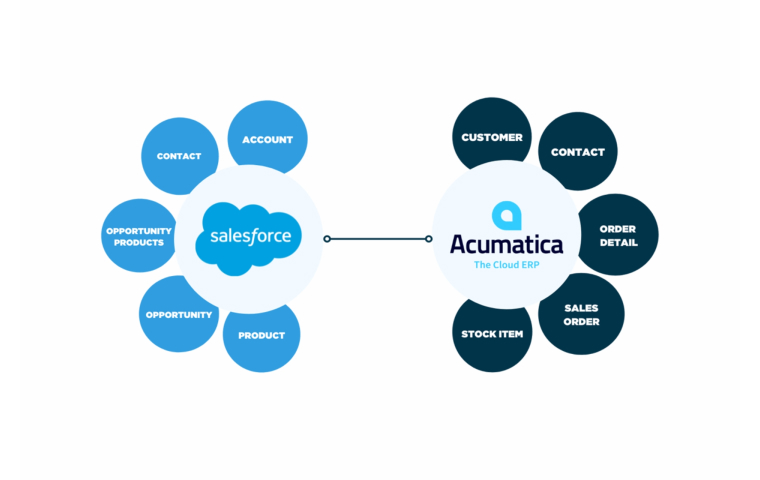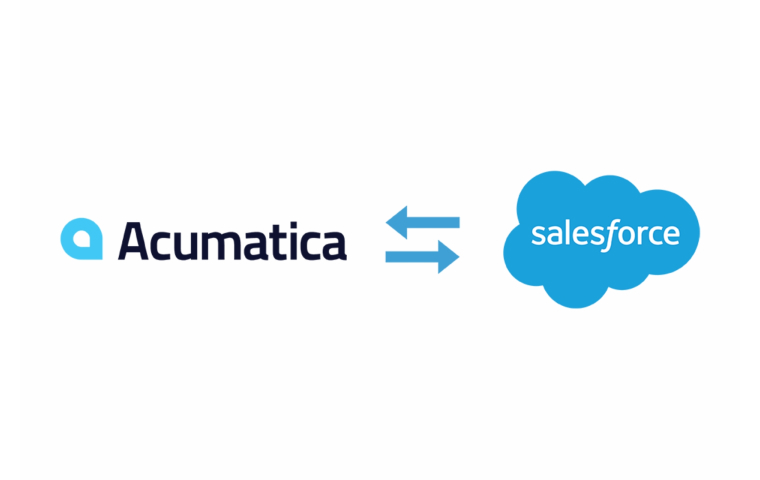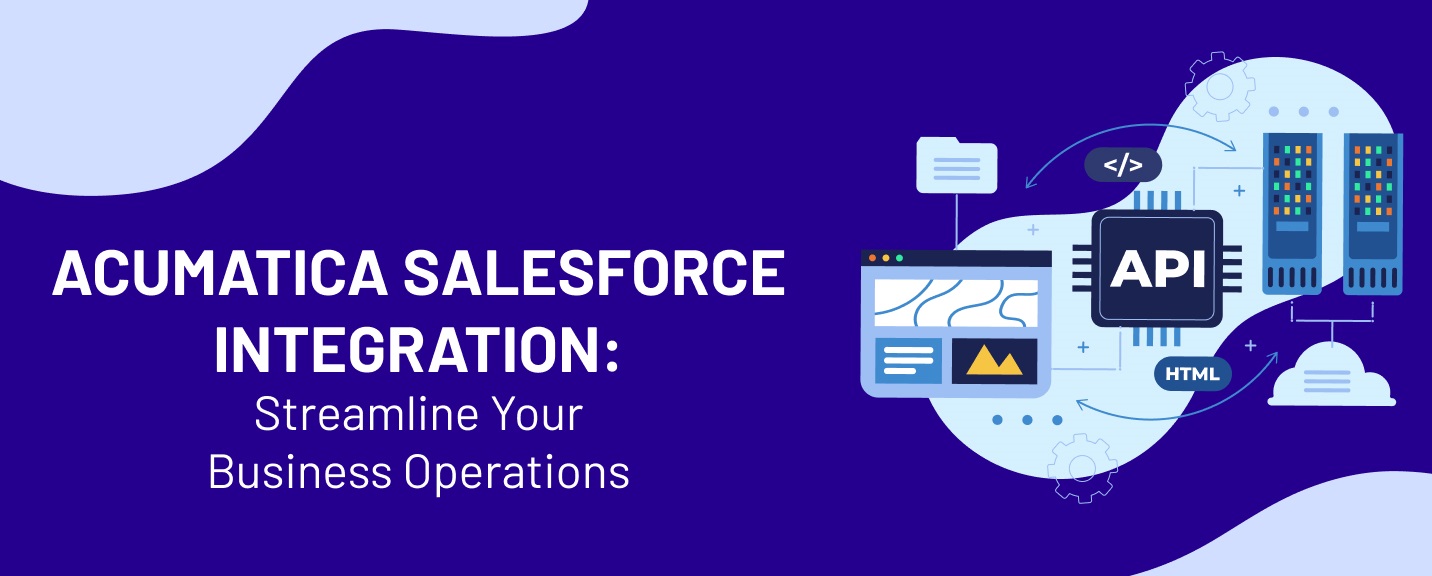TABLE OF CONTENT
Overview Acumatica vs. Salesforce
Why Integrate Acumatica with Salesforce?
Step-by-Step Guide to Acumatica Salesforce Integration
Exploring the Different Integration Options for Acumatica Salesforce Integration
Tips for Optimizing Your Acumatica Salesforce Integration
Best Practices for Data Mapping in Acumatica Salesforce Integration
Conclusion
Overview Acumatica vs. Salesforce
Acumatica is a cloud-based ERP (Enterprise Resource Planning) software that provides businesses with an all-inclusive suite of tools to control their financials, trading, CRM (Customer Relationship Management), and project accounting.
Acumatica provides an up-to-date, mobile-friendly display and is highly customizable to suitable with the unique requirements of your business.
Besides that, Salesforce is also a cloud-based CRM software that assists businesses control their sales and marketing actions. Salesforce supplies a variety of tools to drive business leads, chances, sales, and client interactions.
It offers real-time visibility into your sales conversation and permits you to participate with your team to close agreements faster.

Why Integrate Acumatica with Salesforce?
Integrating them can supply businesses with various advantages that can assist take their activities to the next level while each program has unique effectiveness.
Improved Data Accuracy
Integrating Acumatica with Salesforce can assure certainly across both platforms and data consistency because data that came into one system will be automatically reflected in the other system.
This cancels the demand for data access and decreases the risk of inaccuracies caused by matching data. Businesses can create more informed conclusions, improve buyer experience, and avoid costly wrongs by enhancing data accuracy.
Streamlined Business Processes
Integrating Acumatica with Salesforce can assist businesses streamline their enterprise’s actions, this is because data proceeds seamlessly between the two systems, eliminating the demand for manual data access and lessening the danger of errors.
For example, when a new buyer is added to Salesforce, the client data will be automatically added to Acumatica, excluding the requirement for manual access, this can save time, reduce errors, and enhance operational effectiveness.
Enhanced Visibility into Business Operations and Increased Collaboration
Assimilating Salesforce with Acumatica can assist businesses improve cooperation between different departments. This is because data flows seamlessly between the two systems, allowing other expertises to connect the same data in real-time.
For example, the sales team can access buyer data entered by the finance group in Acumatica, permitting them to supply better customer service and make more informed decisions.
Step-by-Step Guide to Acumatica Salesforce Integration
Step 1: Define Your Integration Requirements
You’ll need to detail your integration necessities before assimilating Acumatica and Salesforce. Consider the following investigations:
- What input do you want to adjust between Acumatica and Salesforce?
- How often do you need the data to be synchronized?
- Do you want a two-way or one-way synchronization?
- Do you need to customize the integration to suitable with your business demands?
Integrating Acumatica with Salesforce can offer businesses real-time visibility into their actions because data flows seamlessly between the two structures, offering businesses a 360-degree aspect of their customers and activities.
This can assist businesses to establish trends, tracking KPIs (Key Performance Indicators), and making informed choices to enhance their business display.
You can plan the integration process accordingly and make sure it meets your business demands by defining your integration requirements.
Step 2: Choose Your Integration Option
There are several selections possible to integrate Acumatica and Salesforce, containing:
- Using a third-party integration tool: You can use third-party integration tools such as Workato, Zapier, or Celigo to link Acumatica with Salesforce. These tools offer pre-built integrations and allow you to customize the assimilation based on your business demands.
- Custom Integration: You can also improve custom assimilation between Acumatica and Salesforce using APIs (Application Programming Interfaces). This choice offers complete management over the integration and permits you to customize it to suitable with your unique business requirements.
Step 3: Set Up Your Integration
Once you’ve selected your integration choice, it’s time to install your integration. Here’s a high-level outline of the steps included:
- Generate an account and authorize the integration tool to connect Acumatica and Salesforce.
- Construct the integration settings based on your integration demands.
- Map the data fields in the middle of Acumatica and Salesforce.
- Test the integration thoroughly to make sure that it works as predicted.
- Set up the integration in a production environment.
Step 4: Monitor and Optimize Your Integration
Once your integration is up and running, controlling and optimizing it endlessly is essential. Consider the coming best practices:
- Monitor the integration logs usually to assure that it’s running easily.
- Please address any errors or issues as soon as they appear.
- Optimize the integration based on your enterprise demands.
- Train your team on how to use the integrated plan and offer growing support.
Pursuing these best practices assures that your assimilation between Acumatica and Salesforce strongly meets your business demands.

Exploring the Different Integration Options for Acumatica Salesforce Integration
Custom Integration
Improving custom assimilation between Acumatica and Salesforce can give you did manage over the integration and permit you to modify it to your unique business demands.
Custom integration can be designed to adjust established data fields, brutalize peculiar processes, and meet specific business requirements.
However, improving a custom integration calls for technical expertise and can be time-consuming and costly.
Third-Party Integration Tools
A third-party integration tool can clarify the integration process and cut down the time and achievement required to improve a custom integration. Third-party tools offer pre-built integrations that can be customized based on your specific demands.
These tools can be configured to synchronize data fields, automatize precise processes, and meet business needs. Third-party tools also supply additional characteristics like error handling, real-time synchronization, and data mapping.
Hybrid Integration
A hybrid integration way combines the advantages of custom and third-party integration engines. While a third-party integration tool is used to synchronize the continuing data fields and automate the remaining actions, custom integration is improved to synchronize the most important data fields and automate the most critical processes in this approach
This approach can lessen the time and effort to enhance a custom integration while providing more powerful management over the synchronization progress.
Cloud-Based Integration
To integrate Acumatica and Salesforce, Cloud-based integration solutions provide a malleable and scalable reach. In this progress, the integration is hosted in the cloud, which offers several advantages, consisting of reduced infrastructure costs, developed scalability, and easier retainment.
Cloud-based integration solutions can provide additional elements such as mapping, data conversion, and real-time synchronization.
Middleware Integration
Middleware integration affects using a middleware tool to unite Acumatica and Salesforce. Middleware tools are intermediaries between the two programs, supplying data conversion, mapping, and other integration factors.
Middleware integration can clarify the integration process, decrease the time and effort required to develop a custom integration, and supply additional characteristics such as real-time synchronization and mistake handling.
Tips for Optimizing Your Acumatica Salesforce Integration
Monitor Your Integration Regularly
Checking your integration regularly is important to assure that it’s running easily. Control the integration logs and dashboards regularly to identify any issues or mistakes. Please address any issues as soon as they arise to avoid them from growing.
Automate Your Data Synchronization
Automating your data synchronization is necessary to assure that your data is logical between Acumatica and Salesforce. Arrange your data synchronization manually to ensure that your data is always up-to-date. Analyze using an automation device to streamline your data synchronization progress.
Clean Up Your Data
Cleaning up your data is crucial to ensure that your data is correct and consistent between Acumatica and Salesforce. Classify duplex records and wipe out them, and assure that your data is formed consistently across both programs.
This will assist you avert mistakes and assure that your data is trustworthy.
Customize Your Integration Based on Your Business Needs
Customizing your integration based on your business needs is essential to ensure that it continues to meet your evolving business needs. Identify areas where the integration can be improved and make the necessary changes to optimize it further.
Consider working with an integration expert to customize your integration depending on your unique enterprise demands.
Optimize Your Workflow
Optimizing your plan can assist you enhance your productivity and, streamline your business actions. Review your business deals and clarify areas where you can develop efficiency. Establish your strategy is optimized to assure your integration is running easily.
Provide Ongoing Training and Support
Supplying ongoing training and help to your team is necessary to ensure they use the integrated system efficiently. Discuss problems or questions rapidly to ensure your team is appropriate with the integrated system.
Analyzing and offering regular training parts to assure your team is up-to-date with the latest characteristics and best practices.
Best Practices for Data Mapping in Acumatica Salesforce Integration
In Acumatica Salesforce integration, data mapping is a vital step that assures the data is synchronized accurately between the two programs. Correct data alignment can save time and prevent discrepancies that can cause costly mistakes.
Understand Your Data
You must figure out the data you’re working with before you start data mapping. This measures identifying the data fields in Acumatica and Salesforce that must be synchronized. To map the data correctly, you also need to understand the data types, formats, and values.
Create a Data Mapping Plan
Generating a data mapping strategy is important to ensure the data is mapped accurately and rationally. The target should be to identify the data fields that demand to be mapped, the data types, and the mapping rules. During the mapping process, the strategy should also determine any data shifts or validations that must be applied to the data.
Use a Visual Mapping Tool
Utilizing a visual mapping device can clarify the data mapping activity and make sure that the data is mapped correctly. Visual mapping tools permit you to map data fields visually by dragging and dropping the fields onto the appropriate fields in the aim system. This wipes out the risk of manual mistakes and assures the data is mapped consistently.
Test the Data Mapping
Testing the data mapping is crucial to ensure it works as predicted. Test the data mapping using real-world scenarios to identify any problems or mistakes. Before deploying the data mapping in a management environment, you need to address any issues.
Monitor the Data Mapping Regularly
Monitoring the data mapping regularly is important to ensure it runs smoothly. To identify any problems or errors, check the data mapping logs usually. Please address any problems as soon as they appear to avoid them from escalating.
Keep Your Data Mapping Plan Up-to-Date
Keeping your data mapping plan up-to-date is necessary to assure that the data mapping goes on to meet your business requirements. Update the data mapping plan whenever there are alterations to the data fields or averaging rules.
This will assist you ensure the data is mapped consistently and correctly over time.
You might be interested in more other our blogs:
Conclusion
Assimilating Acumatica with Salesforce can supply your business with many advantages, consisting of developed data veracity, centralized business actions, and improved visibility into your business activities.
You can reap the full welfare of an integrated system by optimizing it continuously, arranging your integration carefully, and testing it thoroughly.
So, what are you expecting? Consider harmonizing Acumatica with Salesforce today, and take your business operations to the next level, please, contact us today for more help in Acumatica and Salesforce.



